Tomar – access, map, parking, sightseeing, interesting facts, accommodation
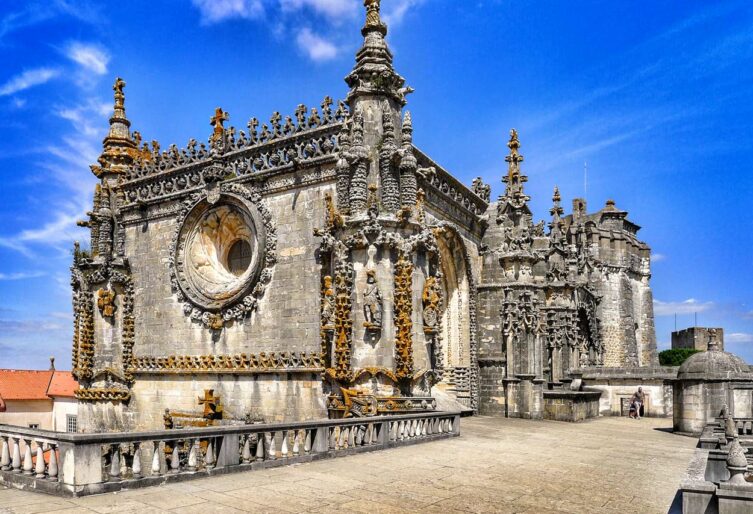
City of the Templars
city history Tomar It started suddenly and has been associated with it from the very first moment The Order of the Poor Knights of Christ and the Temple of Solomon (abbreviated as Templars). And as is often the case with the Templars, this history contains many secrets, legends and superstitions that remain unsolved to this day. However, what is fascinating about Tomar is not only what is unknown, but also what we know for sure. So let's start with some interesting facts.
Gualdim Pais
The creation of Tomar was decided by one man: Gualdim Pais. He was the son of a Portuguese nobleman and knight living in Braga. He also chose the path that connected him with knighthood. For the dedication he showed in battle, the founder of Portugal and its first king Alfonso I the Conqueror gave him a knighthood in 1139.
Not much later, Gualdim Pais went to Palestine and fought as a knight of the Templar order. His career in the order developed so quickly that in 1157 he was ordained a Portuguese priest. Grand Master of the Order. At that time, the capital of the order in Portugal was Braga. Three years later (in 1160), on the orders of the new Grand Master of the Order, Gualdimo Pais, the castle in Tomar was built. The headquarters of the order was moved to Tomar and this is how the history of the city and the order there began.

New opening
The history of the Templar order in Europe ended in one night (I wrote more about it in Portugal sightseeing plan – [click]). The king of France made this happen Philip the Beautiful. He borrowed huge sums of money from the Templars and then was unable to repay them. The Templars became very inconvenient for him. He couldn't get rid of the debt, so he got rid of the creditor and from his perspective, the debt problem disappeared.
The end of the Templar order in Europe (1314) became the new beginning of the order in Portugal. Four years after the fall, the king of Portugal was loyal to the order Dionysius I brought the Templars back to life (1318) under a new name: Order of the Knights of Christ. The extensive Templar estates scattered around the Iberian Peninsula became part of the new order, and in the following year (1319), under pressure from the King of Portugal, Pope John XXII officially established and legalized the new Order of Christ. Portugal became a safe haven and the monks scattered across Europe who managed to survive the hunt that Philip the Fair organized on them began to arrive in Portugal and Tomar.
The real flowering of the order began, which coincidentally and fortunately for the Templars coincided with the era of great geographical discoveries and conquests of new lands. The castle and monastery in Tomar were successively expanded and decorated. There was no shortage of resources and opportunities. Fortune favored the Knights of Christ in Portugal, and Grand Masters of the Order the most important people in the state often stayed:
- Henry the Navigator – one of the greatest explorers, considered the main initiator of the Age of Discovery and the development of the Portuguese Empire
- Manuel I the Fortunatey – king of Portugal during the period of strong development and overseas expansion of the Portuguese Empire (he financed, among others, the expeditions of Vasco da Gama, Pedro Alvarez Cabral, Gaspar Corte-Real, Francisco de Almeida and Alfonso de Albuquerque). The characteristic style of construction and decoration is named after him Manueline style, a perfect example of which is the monastery in Tomar
- John III the Pious – king of Portugal and son of Manuel I the Happy, focused on expanding Portugal's colonial power, colonized, among others, Brazil and the countries of the Far East
Tomar became the place where the most important decisions in the Portuguese empire were made. Even the coronations of Portuguese kings took place there.
One of the most significant events in Portuguese history also took place in Tomar. In 1581, the Portuguese nobility at the assembly held in the Tomar monastery decided that ... they recognized the power and suzerainty of the Spanish King Philip II. Portugal as an independent state ceased to exist and came under the suzerainty of Spain. Regaining independence cost Portugal a lot of time and blood. The Portuguese had to wait 59 years (until 1640) to declare the independence of their country again, and then fight another 28-year war with the Spaniards, who only recognized Portugal's independence under the treaty signed in Lisbon in 1668.
Here you probably have a question: did the Knights of the Order of Christ survive the supervision of the Spanish state, which was not necessarily friendly to them? Yes! They survived. It should be remembered that they were already a legal organization, legalized by the Pope.
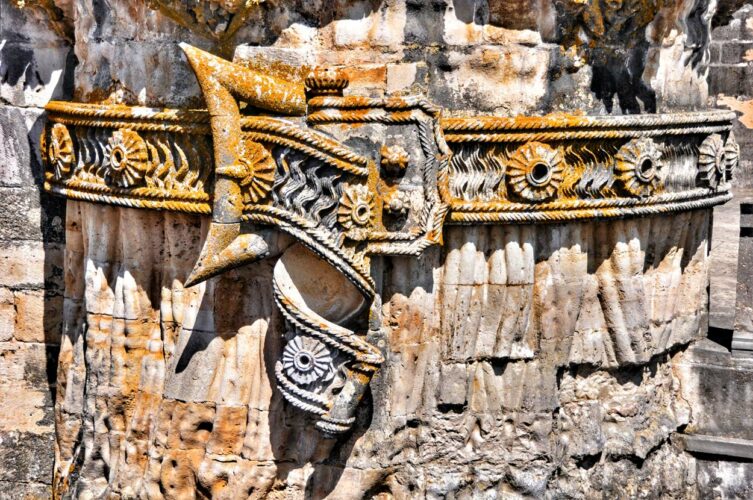
Does the order still exist?
Does the Templar order from Tomar, whose history I described briefly, still exist? Are you asking yourself this question?
I also asked myself this question and it turned out that the rest of the story is still extremely interesting, because the order still exists, but its Grand Master is... the president of Portugal!
After many transformations, forced secularization, changes in names and forms of functioning, the order is now called: Military Order of Christ (Ordem Militar de Cristo). It was transformed into one of Portugal's most prestigious state awards, awarded only to outstanding personalities. Knights of the Order of Christ include: Elizabeth II (the Queen of Great Britain recently died), Napoleon Bonaparte (no need to change), guangxu (penultimate emperor of China), Jacques Chirac (President of France). There are also Poles who are knights of the order (21 people in total). Among the first Poles to receive this honor in 1931 was the year Jozef Beck.
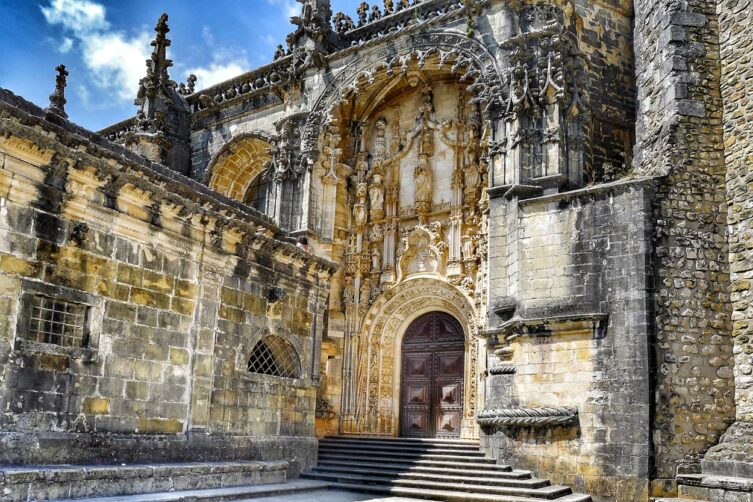
The exciting secrets of Tomar
The secrets of the Templars from Tomar still arouse the minds of historians, tourists and, most of all, treasure hunters. The mythical treasures of the Templars have inspired many stories, legends, books and films. This is hardly surprising. It is enough to think back to the moment when the fabulously rich order was suddenly liquidated due to the actions of the king of France. So what happens to the property and wealth of liquidated monks? It is highly probable that they are reached and discreetly taken over by the authorities of the countries where the monks had them. Well, yes, but some of the monks manage to survive and reach a safe asylum in Portugal and Tomar. When they run away, they probably take with them what is most valuable. So people and their valuables flow to Tomar. The monastery is thriving, developing under the supervision and support of the most important people in the state, accumulating and expanding its wealth.
So does the Templar treasure really exist and hasn't been found yet? Is it located in Tomar? Here, the imagination suggests various scenarios and finds favorable ground. The castle and monastery of Tomar is full of hidden rooms, underground corridors, dead ends and secret passages. New discoveries appear from time to time, and a large part of the facility is closed and simply inaccessible to anyone (including the Monastic Chapel, the Monastic Library, Private Monastic Quarters, and an underground water reservoir).
One of the most interesting secret passages is the corridor connecting the castle with the Nabao River, serving as an escape route from danger or as a secret transport route for supplies during a siege. Almost all secret, underground corridors are inaccessible to visitors, and one of the official reasons is... the possibility of getting lost in them. So the question arises: how many of them are there that you can get lost in?
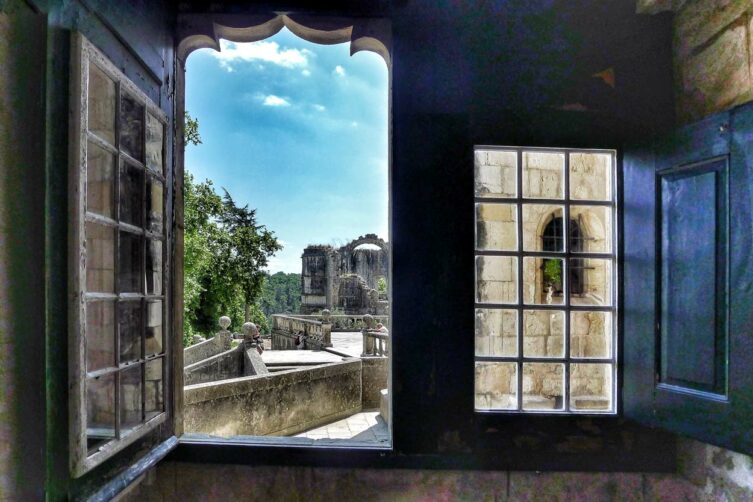
Without a doubt, Tomar hides a huge number of secrets from us, and many of them remain undiscovered to this day. One of the widely available and still unexplained curiosities is Courtyard of Words. Words and maxims are carved on the stone slabs of the courtyard. Some, although decipherable, remain difficult to understand, which means that their meaning has not been explained to this day.
We will probably enjoy new discoveries in Tomar for a long time, and sightseeing will still have that note of excitement that there are still extraordinary secrets lurking beneath our feet. It's definitely nice to read about newly discovered secrets, knowing that we were so close to them.
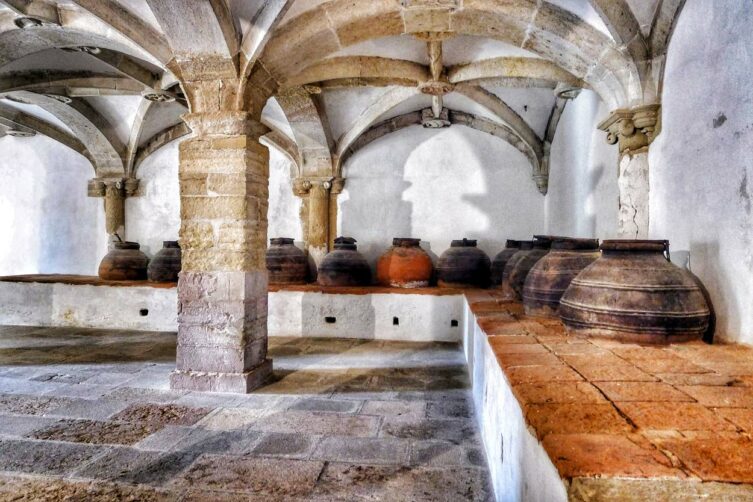
Visiting Tomar
Most people who come to Tomar focus mainly on the Templar monastery. However, it is worth looking beyond the monastery and seeing at least a small part of the city. Especially since the most interesting parts of the town of Tomas are just a few steps from the monastery.
Take a look at the map I prepared. You will find the location of the parking lot and the most important attractions there. The parking lot I propose is located exactly between the most interesting part of the city and the Templar convent. A really short walk is enough to see everything at once.
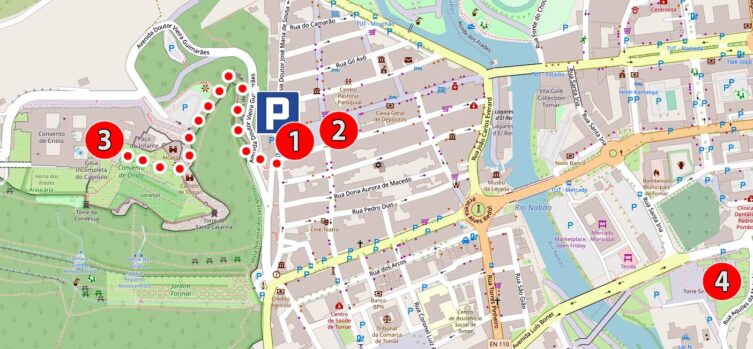
Underground parking right next to the market square, in the historic part of Tomar, GPS coordinates:
39°36’14.2″N 8°24’56.4″W
39.603948, -8.415675 - click and route
from this parking lot it is very close to the monastery of the Order of Christ, so you can walk there.
A small parking lot in front of the monastery of the Order of Christ, GPS coordinates:
39°36’14.3″N 8°25’02.2″W
39.603976, -8.417276 - click and route
1. Tomar Town Hall
The town hall building, built in the XNUMXth century, is undoubtedly the decoration of the market square, dominated by the monument of Gualdim Pais, the founder of the city and the first Grand Master of the Order of Christ in Tomar.
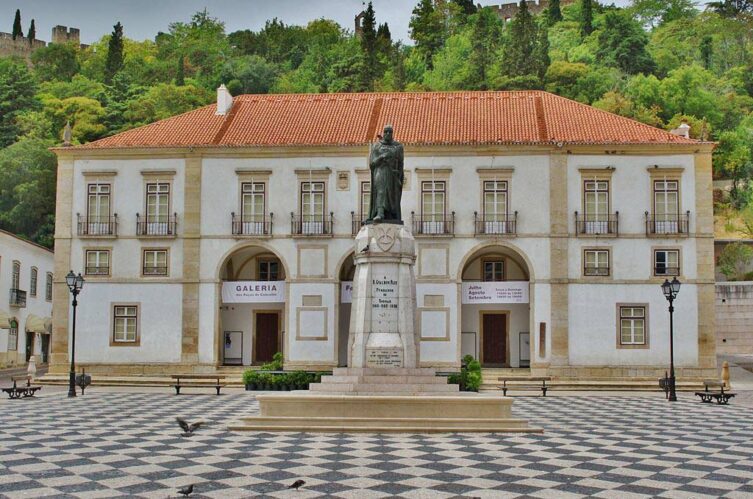
photo: Filipefirix on principles CC BY-SA 3.0
Underground parking right next to the town hall and market square, in the historical part of Tomar, GPS coordinates:
39°36’14.2″N 8°24’56.4″W
39.603948, -8.415675 - click and route
2. Church of Saint John the Baptist (Sao Joao Baptista)
Decorated in the Manueline style, dating back to the XNUMXth century, a beautiful church with an adjacent bell tower.
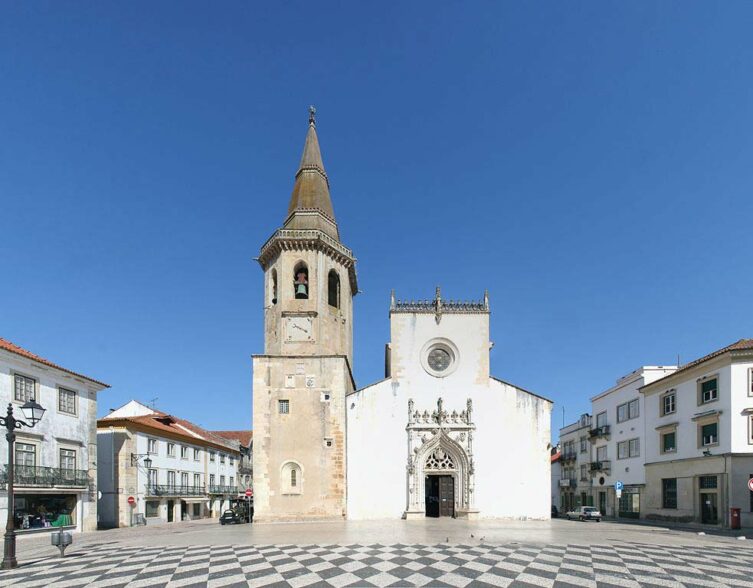
photo: Ingo Mehling on principles CC BY-SA 3.0
3. Monastery of the Order of Christ (Convento de Cristo)
The main attraction is Tomar and the main character of this post. The entire entry is about him, so additional information is not needed at this point.
4. Church of Santa Maria dos Olival
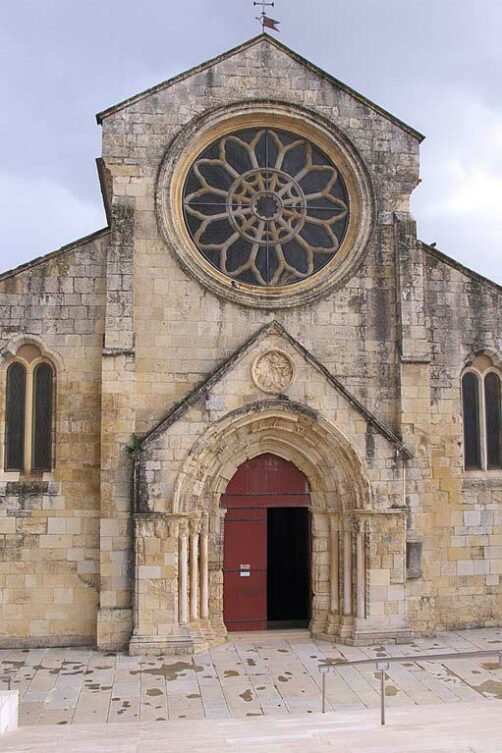
photo: José Luis Filpo Cabana on the rules CC BY-SA 4.0
A sightseeing point for the particularly inquisitive. This church, built in the XNUMXth century, houses the tomb and the remains of Gualdimo Pais - the founder of the church, founder of the city and the first Grand Master of the Order of the Knights of Christ.
However, Gualdim Pais was not the only Templar buried here, because the church served as a pantheon of the Masters of the Order for a very long time. Other Great Masters also found their resting place there.
Curiosity:
After the liquidation of the Templar Order in 1314, it was this modest church (and not the Convento de Cristo monastery) that was the official seat of the new Order of Christ.
Parking lot at the church of Santa Maria do Olival, GPS coordinates:
39°36’04.8″N 8°24’30.4″W
39.601336, -8.408436 - click and route
Plan of the monastery of the Order of Christ in Tomar
Below I have included a map of the castle and monastery in Tomar, marking its most important parts. The facility is large, so a few moments devoted to this map will make it easier to find the most interesting parts that you absolutely must see.
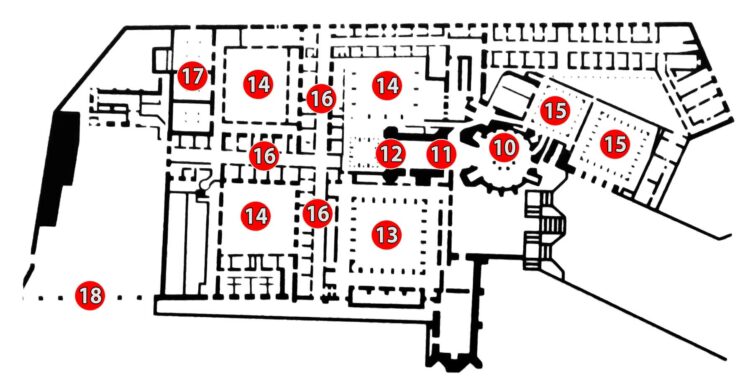
10. Charola (round church of the Templars)
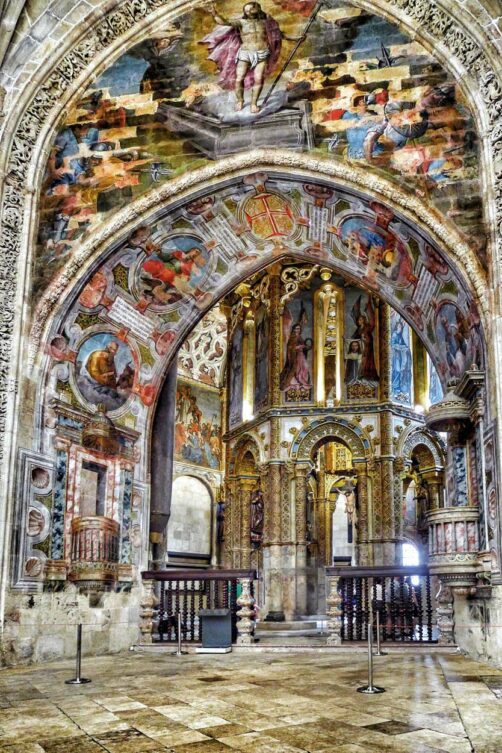
The so-called Round Church (built in the XNUMXth century) has the shape of a regular sixteen-sided polygon on the outside. Inside, it has a centrally located octagonal structure, which is connected to the external hexagonal structure by arched vaults.
The structure of the church is modeled on Basilica of the Holy Sepulchre and Dome of the Rock in Jerusalem.
The shape of Charola and other parts of the church adjacent to it are perfectly illustrated in the drawing below.
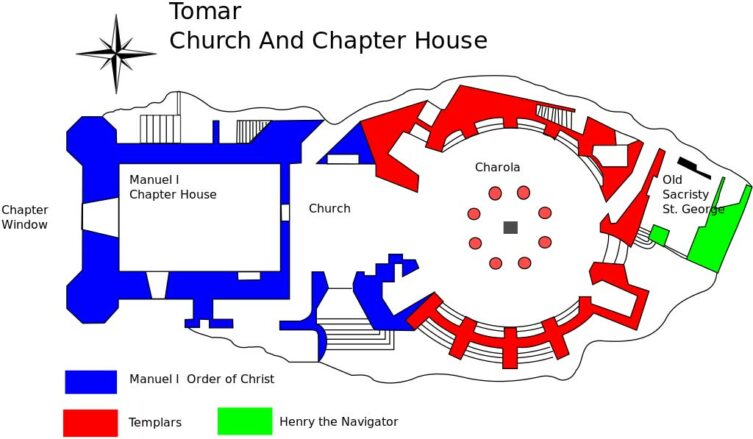
photo: Gorivero on terms CC BY-SA 3.0
11. Manueline nave of the church
The nave added to the Round Church in the first half of the XNUMXth century, when Henry the Navigator was the Grand Master of the Order, is a perfect example of the Manueline style, i.e. a combination of late Gothic and Renaissance, with characteristic, very rich decorations containing natural and maritime elements.
12. Manueline window
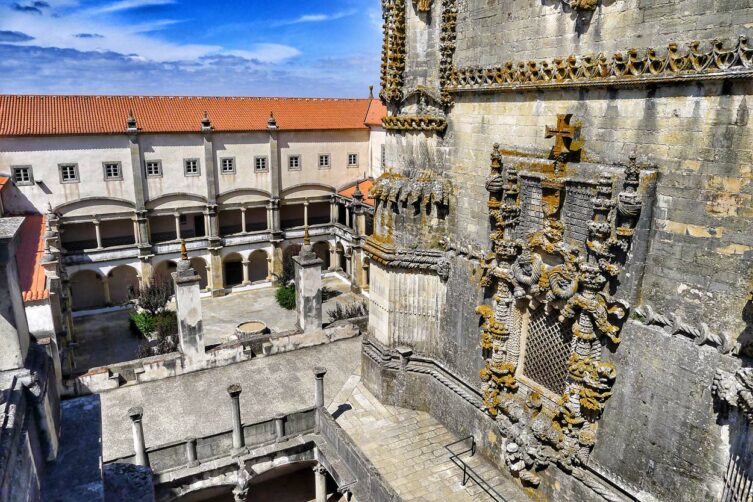
The window is surrounded by extremely impressive Manueline decorations. Elements related to the sea are clearly visible here. Work on decorating just this one window lasted for three years. The human face in the lower part of the window probably represents the author of the decorations, Diogo de Arruda.
In the upper part of the window there is a cross, a symbol of the Order of Christ. The shape of the cross is closely related to the shape of Charola, i.e. the Round Church. The arms of the cross are the result of their basic architectural shapes. This is well illustrated in the figure below.
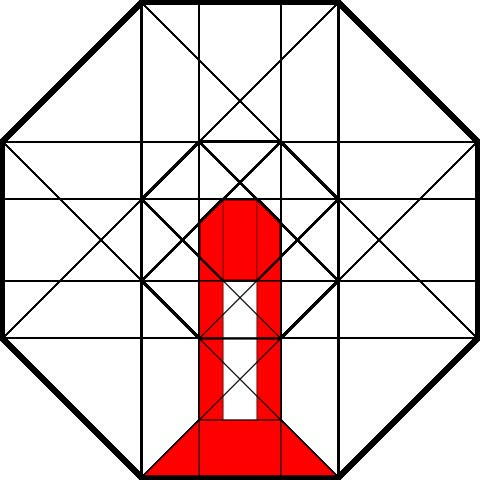
photo: user:Giro720 under Public Domain rules
13. Monastery of John III (Claustro de D. Joao III)
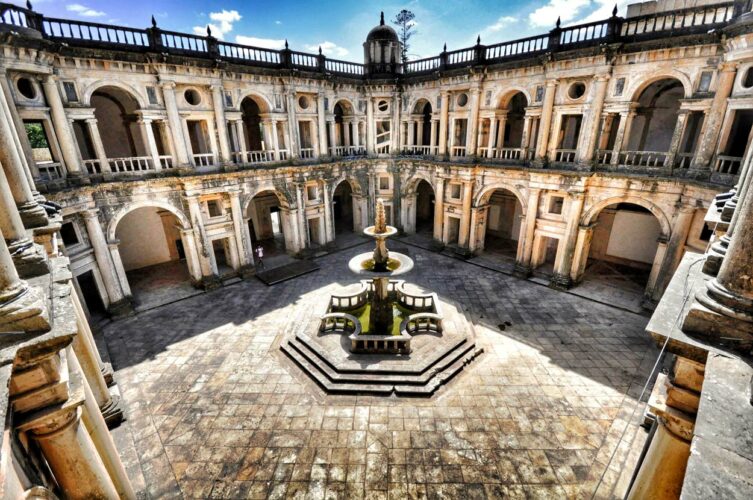
The monastery that originally existed in this place was almost completely demolished for unknown reasons after the death of the architect Joao de Castilho. It was replaced by a building designed by Diogo de Torralva, which is now considered a masterpiece of European Mannerism. The building is really impressive, and getting to know it is a lot of fun, especially since you can enter almost everywhere.
14. Renaissance cloisters
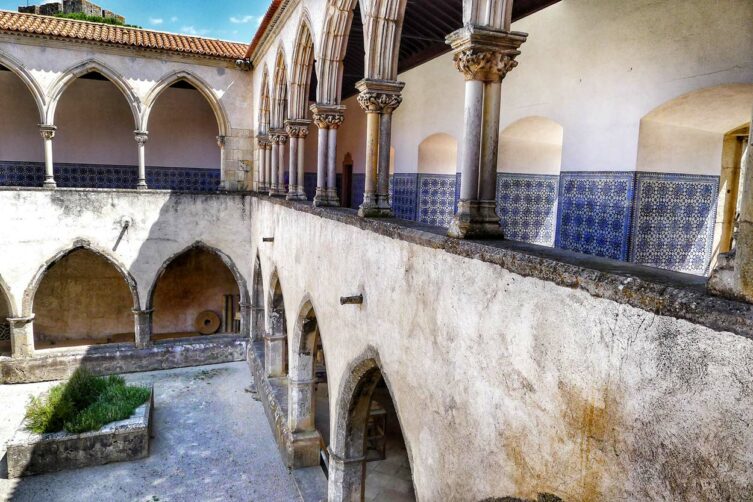
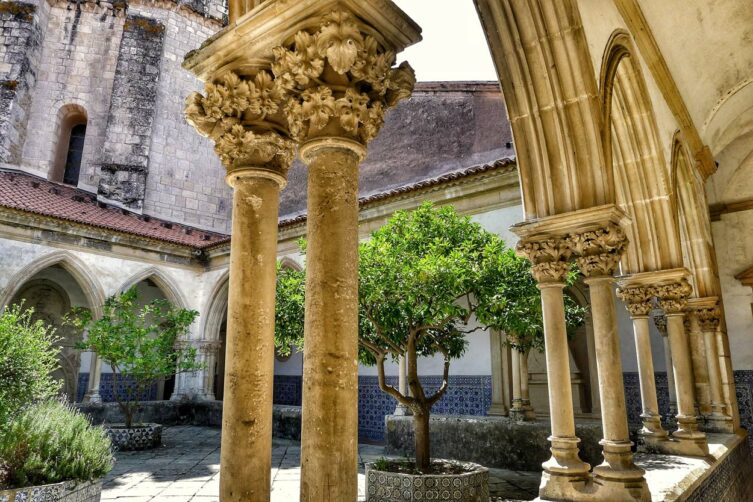
The system of corridors used in the monastery divides the main body into four parts forming cloisters, each of which has its own character. The cloister located behind the western facade of the Manueline church has what appear to be unfinished columns. In fact, the columns remained after the demolition of the first floor of the cloister, which was removed because it significantly obscured the decorations of the Manueline church.
15. Gothic cloisters
In the Gothic cloisters, it is worth paying attention to their structure, which takes the form of broken arcades.
16. Renaissance dormitories
The dormitory, i.e. the monks' bedrooms, along with the corridors are crowned with beautiful barrel vaults with oak wood coffers.
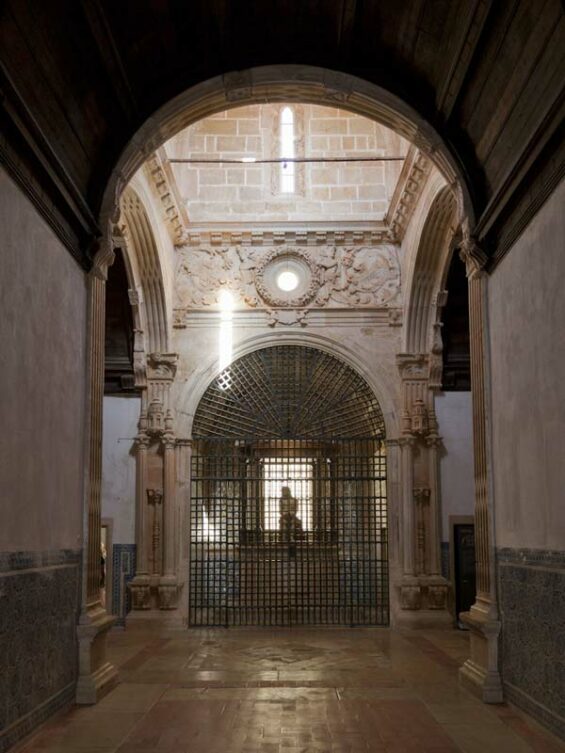
photo: Manuelvbotelho on terms CC BY-SA 4.0
17. Novitiate rooms
The most interesting thing in the novitiate rooms are the vaults (one in particular) where the barrel vaults create a sophisticated architectural arrangement supported by Corinthian columns.
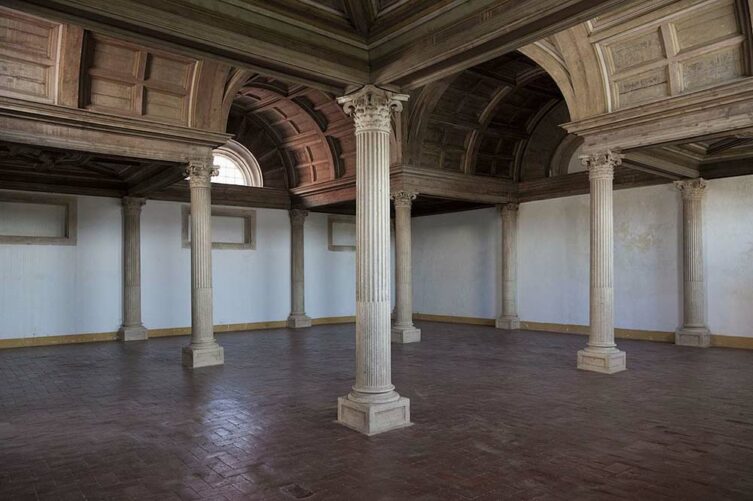
photo: Manuelvbotelho on terms CC BY-SA 4.0
18. Aqueduct, New Gate and monastery hospital
A few words about the aqueduct, it is worth noting that the cloisters of the monastery were designed in such a way as to collect and store rainwater in special cisterns hollowed out under the monastery. The rainwater collection system was so efficient that it fully covered the monastery's water needs and did not allow for irrigation of the fields adjacent to the monastery. Then the idea of building an aqueduct was born, which would provide enough water to enable artificial irrigation of fields.
The aqueduct, which ends in the monastery with a row of seven long arches, has a total length of approximately 6 kilometers. There are a total of 180 arches along its entire length. It is a beautiful and extensive project that required extensive engineering and hydrological knowledge. The water supplied by the aqueduct comes from four different sources. The construction of the aqueduct lasted for 21 years (1593 – 1614).
The aqueduct operated actively from 1614 until the mid-330th century, providing water continuously for over XNUMX years.
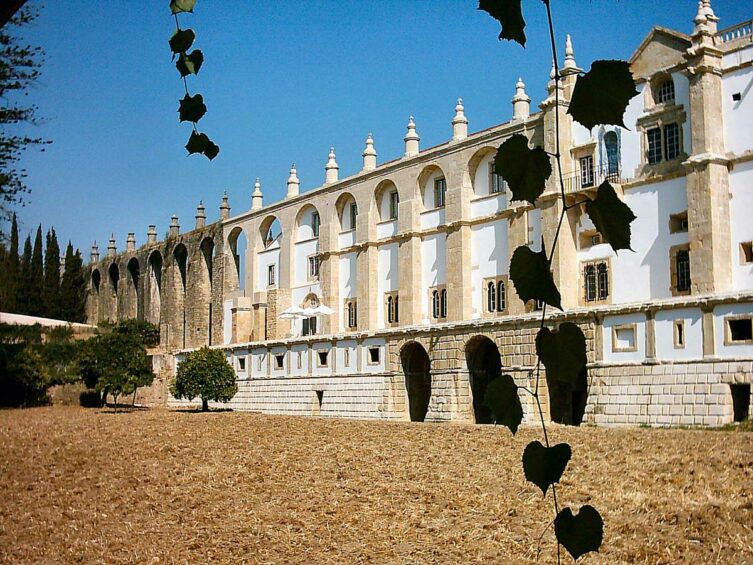
photo: Juntas on principles CC BY-SA 3.0
Tomar – accommodation
If you decide that it is worth staying overnight in Tomar, finding good and cheap accommodation should not be a problem. Take a look at some suggestions below. They have very high ratings and an attractive price. Clicking on any of them will take you to a detailed description and will also display several similar accommodations available nearby. The links I prepared were designed to filter out unnecessary results. Using them should make your search much easier.
Bairro das Flores – [click]
Pé do Castelo Casinha – [click]
Horta dos Cedros – [click]
Portugal sightseeing plan
This entry is part of a complete one Portugal sightseeing plan - [click]. The guide contains plans, maps and descriptions of specific sightseeing routes.To see all currently available descriptions of attractions in Portugal, click on the link: Continental Portugal - [click].
Safe car rental guide: Portugal - car rental without credit card, no deposit
Important to me!
Give the article a good rating (5 stars welcome 😀)!It's free, a for me it is very important! The blog lives on visits and thus has a chance to develop. Please do it and ... thank you in advance!
If you like my guides, you will certainly find the one I created useful guide catalog - [click]. There you will find ready-made ideas for your next trips, descriptions of other tourist destinations and an alphabetical list of guides divided into countries, cities, islands and geographical regions.
I also post link to Facebook profile - [click]. Come in and press "Follow"then you will not miss new, inspiring posts.
Unless you prefer Instagram. I'm not a social media demon, but you can always count on something nice to look at on my instagram profile - [click]. The profile will gladly accept any follower who likes it.
I make the content I create available free of charge with copyright, and the blog survives from advertising and affiliate cooperation. So, automatic ads will be displayed in the content of the articles, and some links are affiliate links. This has no effect on the final price of the service or product, but I may earn a commission for displaying ads or following certain links. I only recommend services and products that I find good and helpful. Since the beginning of the blog's existence, I have not published any sponsored article.
Some of the readers who found the information here very helpful, sometimes ask me how you can support the blog? I do not run fundraisers or support programs (type: patronite, zrzutka or "buy coffee"). The best way is to use links. It costs you nothing, and support for the blog is self-generating.
Pozdrawiam




We were there in May '23. Magic place. Charola is ……no words. For me it's a miracle. The entrance from the courtyard was closed and under renovation, as was the famous window. Well, better late than never. Overall, it requires a lot of renovation. Interiors and courtyards – wonderful. The magic of the place stays for a long time. I would highly recommend
Dariusz